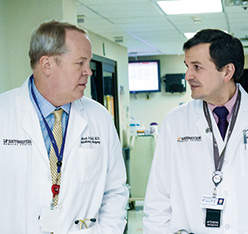Portable ECMO Machine Adds Another Option to Lung Transplant Program Portfolio
December 31, 2014

A year and a half ago, Courtney White was, by all accounts, at death’s door from end-stage lung disease. The then-23-year-old had been admitted to UT Southwestern a few months earlier with breathing difficulties resulting from the cystic fibrosis she’d lived with most of her life. While she was in the hospital, suddenly, one of her already weakened lungs collapsed.
“We thought we were losing her,” her mother, Laura, recalls. “If not for the quick response by the UT Southwestern team and the advanced equipment they had, I guarantee you, Courtney would not be with us today.”
The case became a milestone for UT Southwestern’s Lung Transplantation Program because it was the first time the team deployed one particular piece of advanced equipment it had recently acquired for just such an emergency situation: a portable ECMO (extracorporeal membrane oxygenation) machine capable of replacing or assisting a patient’s circulation and respiration.
Offering Much-Needed Time
ECMO technology is now more than 60 years old, but the mass of equipment involved in the original 1953 model of the machine very nearly filled a patient room. Even today, the ECMO machines typically used in operating rooms during transplant and open-heart surgeries are approximately the size of two washing machines. The portable version credited with saving Courtney’s life is closer to the size of an Igloo cooler, and central to its design is how quickly and easily it can be connected to a patient in need.
“The technology wrapped up in this compact machine is revolutionary and lifesaving,” says Fernando Torres, M.D., Medical Director of UT Southwestern’s Lung Transplantation Program and one of Courtney’s physicians. “The portable ECMO machine is ideal for bridging the sickest patients either to transplantation or LVAD therapy and, ultimately, to recovery. Essentially, it can give us much-needed time to assess the situation and, as in Courtney’s case, find the organs we need.”
Once Courtney was placed on the portable ECMO machine, Dr. Torres and the surgical team moved her to the top of the waitlist for a double lung transplant. It took a week to obtain the organs, during which time the small machine maintained Courtney’s circulatory system.
Fast-Forward
Now 25, Courtney not only has recovered from her transplant but, according to her mom, is more active than at any point prior to her surgery. Well-versed in the ins-and-outs of the medical system after living most of her life as a patient, Courtney is currently taking classes toward becoming a medical transcriptionist.
“She’s so happy and overjoyed with life, and it’s amazing to watch her go,” Laura says. “We are truly blessed by all the UT Southwestern doctors, nurses, and staff who were involved in getting her where she is today. And I can’t tell you how many people we have told about the ECMO machine and what it did to save Courtney’s life!”
Since its inaugural and dramatic debut at UTSW, the portable ECMO device has become an important tool in the Lung Transplant Program’s arsenal of advanced equipment, according to Dr. Torres.
“It’s exactly the technology you want to have on hand when you have a patient who is suddenly at the brink of death,” he says. “It’s technology that can buy time and provide the transitional bridge such a patient needs, and that’s how we continue to use it.”










